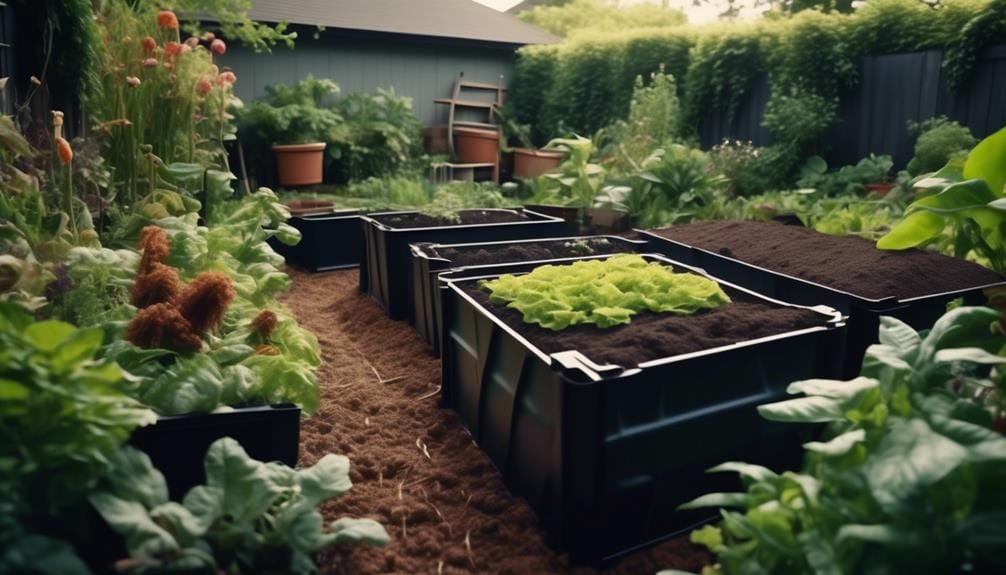Are you tired of seeing your food scraps go to waste in the landfill? Well, get ready to uncover the secrets of DIY composting and unlock a world of sustainable solutions for reducing your household waste.
Not only will you be doing your part to help the environment, but you'll also be creating nutrient-rich soil for your plants. Whether you have a backyard or live in an apartment without a balcony, we have tips and tricks for every situation.
But how exactly does composting work? And what materials do you need to get started? Keep reading to discover everything you need to know about DIY composting and how it can make a positive impact on the planet.
Key Takeaways
- DIY composting is a sustainable solution to reduce greenhouse gas emissions caused by food waste.
- Compost bins can be made and maintained in various settings, including apartments and backyards.
- The necessary materials for a DIY compost bin include a plastic storage bin with a lid, a drill for airflow, shredded paper and dried leaves, soil, and food scraps.
- Composting involves a simple process of adding layers, maintaining moisture and proper mixture, and using the compost in house plants or gardens.
Reasons for DIY Composting
If you're looking for a practical and eco-friendly way to reduce household waste and contribute to a healthier environment, DIY composting is an excellent solution.
There are several advantages to making your own compost. Firstly, food scraps don't break down in landfills, but composting allows them to decompose naturally. Landfills lack oxygen, which prevents decomposition and leads to the release of methane, a potent greenhouse gas. In fact, food waste is the third-largest emitter of greenhouse gas emissions.
By composting, you can reduce household waste by 50% and minimize your environmental impact. DIY composting is accessible even for those living in apartments without a balcony. Backyard composting requires choosing the right compost bin, and adding worms can speed up the decomposition process.
Storing Your DIY Compost
To properly store your DIY compost, consider the available options based on your living situation and the type of compost bin you're using. Whether you're composting in an apartment without a balcony or in your backyard, here are some practical tips to help you store your compost effectively:
- Apartment composting without a balcony: If you don't have outdoor space, place your compost bin near a window or under a sink. Use airtight containers to store your compost until you can transfer it to a community garden or local composting facility.
- Backyard composting tips: Choose a compost bin that suits your needs, such as a tumbling composter or a traditional compost pile. Place the bin in a shady area with good airflow, and regularly turn and mix the compost to speed up the decomposition process.
Remember to maintain the proper balance of greens and browns, keep the compost moist but not soggy, and avoid adding meat, dairy, and oily foods to prevent rodents and pests.
Happy composting!
Materials Needed for a Compost Bin
Now that you understand the importance of proper storage for your DIY compost, let's explore the essential materials needed to create a compost bin.
When it comes to compost bin alternatives, you have a few options. One popular choice is a plastic storage bin with a lid, which provides a convenient and affordable solution. Another option is using wooden pallets or wire mesh to create a bin.
When it comes to compost bin placement, it's important to choose a location that's convenient for you and allows for proper airflow. Placing the bin outside on a porch or balcony is a great idea, as long as it receives adequate sunlight and is easily accessible.
Remember to drill holes in the bin for airflow and add a base layer of shredded paper and dried leaves. With these materials, you'll be well on your way to creating a successful compost bin.
Building a Compost Bin
Creating your own compost bin is a simple and effective way to reduce waste and enrich your soil. Building a compost bin offers numerous benefits, including reducing greenhouse gas emissions and decreasing household waste. Troubleshooting common composting problems is also essential to ensure successful decomposition.
Here are five key steps to building your compost bin:
- Choose the right bin: Opt for a plastic storage bin with a lid that provides sufficient space for composting.
- Create airflow: Drill holes in the bottom and sides of the bin to allow for proper ventilation.
- Establish a base: Start with a layer of dried leaves, shredded paper, or cardboard to provide a foundation for the composting process.
- Add decomposers: Introduce soil to kickstart the decomposition process and enhance the breakdown of food scraps.
- Maintain and manage: Regularly mix the contents, maintain a good balance of food scraps and paper, and water the compost to keep proper moisture levels.
Maintaining a Compost Bin
Maintaining a compost bin requires regular attention and proper management to ensure successful decomposition and nutrient-rich compost.
To troubleshoot common composting problems, start by ensuring that your compost bin has a good balance of green and brown materials. Green materials include food scraps and grass clippings, while brown materials include dried leaves and shredded paper.
If your compost smells bad, it may be too wet or have too much green material. In this case, add more brown material and mix the compost to improve airflow.
If your compost isn't decomposing, it may be too dry. Simply add water and mix the compost to increase moisture levels.
For those composting in small spaces, consider using a worm bin or a countertop composting system. These options require less space and can still produce nutrient-rich compost for your plants.
Remember to regularly monitor and turn the compost to ensure proper decomposition.
Using the Compost
To fully reap the benefits of your homemade compost, it's time to explore how to effectively utilize it in your house plants or gardens. Here are some creative composting ideas to help you make the most of your nutrient-rich compost:
- Use it as a top dressing: Spread a thin layer of compost around the base of your plants to provide them with a slow-release source of nutrients.
- Make compost tea: Mix compost with water and let it steep for a few days. Use this nutrient-rich liquid to water your plants or as a foliar spray.
- Start a compost pile in your garden: Use your compost as a starter for a new compost pile by layering it with other organic materials like leaves, grass clippings, and kitchen scraps.
- Create compost mulch: Spread a thick layer of compost around your plants to suppress weeds, retain moisture, and improve soil structure.
- Share it with your community: If you have excess compost, consider sharing it with friends, neighbors, or local community gardens.
Using your homemade compost not only benefits your plants but also the environment. By diverting organic waste from landfills, you're reducing methane emissions and helping to combat climate change. So get creative and start using your compost to nourish your plants while making a positive impact on the planet.
Common Composting Questions
When it comes to composting, you may have some common questions that need answers. One common question is, 'What can I use as a compost bin alternative?' If you don't have access to a plastic storage bin, you can use other materials such as old wooden crates, metal containers, or even repurposed trash cans. The important thing is to ensure that the alternative bin has proper airflow and drainage.
Another common question is, 'How to troubleshoot common composting problems?' If you notice that your compost smells bad, it may be too wet or lacking enough oxygen. To fix this, add dry materials like shredded paper or dried leaves and turn the compost to improve airflow. If your compost isn't decomposing, it may be due to a lack of nitrogen-rich materials. Add more green waste, like fruit and vegetable scraps, to balance the carbon-nitrogen ratio. Remember to regularly check and adjust the moisture levels and mix the contents of the compost bin to ensure successful decomposition.
Conclusion
In conclusion, DIY composting is a simple and practical solution for reducing food waste and helping the environment.
By transforming your food scraps into nutrient-rich compost, you can make a positive impact on the planet while also benefiting your plants and garden.
Whether you live in an apartment or have a backyard, there are tips and tricks for every situation.
So why wait? Start composting today and unlock the secrets to a greener and more sustainable lifestyle.

